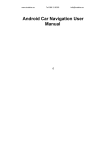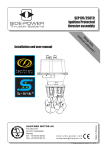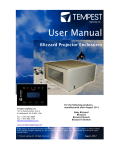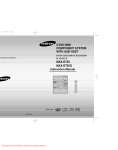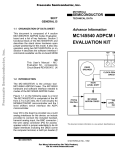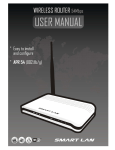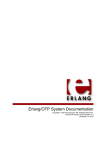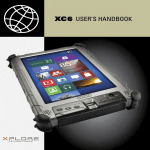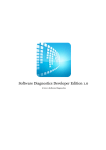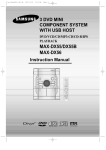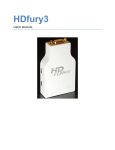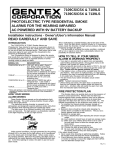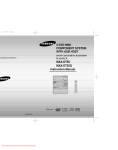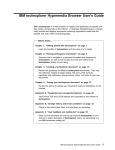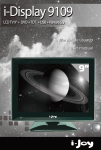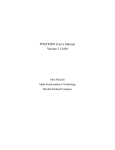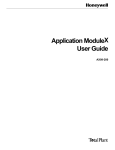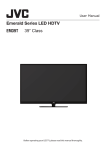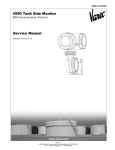Download User manual - Genee India
Transcript
GENEE TECHNOLOGIES INDIA PRIVATE LIMITED An ISO 9001:2008 certified company ® Classroom for the Future 8100 ® 8100 Tel: 0124-4934500 @ Email: [email protected] Website: www.genee-india.com, www.geneeworld.com WWW Plot No. 698, Udyog Vihar, Phase V, Gurgaon, Haryana-122016, India Fax: 0124-4934521 User manual PRECAUTIONS PRECAUTIONS NOT THIS WAY Please follow these precautions: SPECIFICATIONS To prevent fire or shock hazard, do not expose the unit to rain or moisture. To Colour prevent electrical the cabinet. Refer to qualified PALopen system system shock, do not personnel for service only. professional CCDwith camera DoPickup not use device the unit continuously1/4” for more than 24 hours auto focus on. It may cause damage to the camera lens. Be Resolution careful not to spill water or other onto the SVGA unit, or(800x600) allow XGA liquids (1024x768), combustible or metallic objects to get inside the cabinet. Totalthe Pixels 470,000 Unplug visualiser from the wall outlet when it is not being RGB pixels used for Output a long period of time. 780,000 Clean the cabinet with a soft cloth moistened mild zoom 22xlightly optical zoom,with 10xadigital Lens detergent solution. Focus/Iris Clean the lens carefully with an Auto/manual air spray or softselectable dry cloth to avoid scratching it. Auto White balance When the lamps flash or become dark, they should be replaced with new ones. Yes Image split Avoid switching arm lights and back light frequently. Negative/positive Remove the camera lens cap before power the unit on. conversion Black/white and colour selection Image freeze Mirror Lights Input connections PARTS IDENTIFICATION PARTS IDENTIFICATION Audio: Mini jack 2 MIC: Mini jack 1 PC Audio: Mini jack 2 RGB: DB15FLC2 RGB: DB15FLC2 C-Video: RCA jack 1 Output connectors S-Video: 4 pin mini Din 1 Audio: Mini jack 1 Operating System Window 2000/XP USB connector 30 frames/sec RS-232 connector 9-pin, D-Sub, male/6-pin PS/2 USB port USB 2.0 12V/4A external AC adaptor Power requirements Folded: 20.0”x16.1”x4.7” Dimensions (WxDxH) Setup: 20.0”x20.9”x22.4” Packing: 25.6”x21.3”x9.1” N.W: 5.5g (12.1lbs CONTROL Weight PANEL G.W: 9.5g (20.9lbs) Mir Yes Ppw Yes Yes Yes Arm light: 1.5W LED lamps x 2 Back light: 4 W LED lamps C-Video: RCA jack 1 S-Video: 4 pin mini Din 1 Frz Neg Far Accessory Pin Title AC powerCCD/PC1/PC2 cord VIDEO RGB cable Audio/Video cable + Computer RS232 cable (9-pin to W 9-pin) T POWER Projector RS232 cable LAMP AUTO(6-pin to 9-pin) USB cable Audio convert cable AC adaptor User’s manual Software CD Infrared remote control Warranty card POWER (Control the visualiser On/Off) Mir (V-reverse the image) Frz (Freeze the image) Neg (Display film negatives) disconnect thethe projector thescreen) RS232 port first) and select the Baud Rate and Title (Freeze top 1/8from of the Parity based on the projector’s Baud Rate, then click the “TEST” button to pop up the D./S. (Switch between static mode and dynamic mode) Projector Code Test dialogue box, input the Baud Rate and Parity based on the Far/Near (Focus far or near) projector’s Baud rate, then click “Open”. Split (Image Split function) Ppw (Control the projector On/Standby) Pin (Projector input signal selection) / (Move the image up/down) CCD/PC1/PC2 (CCD/RGB input signal selection) S-VIDEO /VIDEO (Video input signal selection) LAMP (Control the arm lights and back light) AUTO (To auto adjust white balance and auto focus) T/W (Increase and decrease the magnification) Remarks: Frz,Frz, Title, D./S.D./S. and and Split Split functions are only on PROJECTOR OUT port. Remarks: Title, functions areavailable only available on REMOTE CONTROL REMOTE CONTROL 2. Rotate the camera head clockwise until the camera head is parallel to the camera stand, carefully Fold the camera stand down to the front panel. PROJECTOR OUT port. BUTTON INSTRUCTION Button function instruction sheet INSTRUCTION BUTTON Click the projector control buttons on the visualiser’s operating panel to check if Button function instruction shee the control code that the program received is the same as the sending code. If the receivingButton code Instruction is same to the sending code,Instruction the input codes are correct. If the Indicator Fold/Setup Instruction visualiser can not control the projector, please do the following. 1. Check to see control codes of projector are correct. Freeze Image if the source Negative/Positive CCD /PC1/ PC2 S-V ideo/V ide o 2. Check toMirrormake sure theFreezconnection e the Top 1/8 of the Screen between the visualiser and the projector is Im age correct.Dynamic/S tatic Mode Move Image Up FOLDING THE UNIT Move Image Down S plit Screen POWER Aut o Ad just Color Projector Power arm lightProjector 1. Fold the right down first onto the base, then the left arm down. Input Selec t Brightn ess and Focus On/Standby Mir Fr z Neg D./S. Far Near Split Ppw Pin Title Focus Adjustment Press and H old Two S econds to P ower Off Vis ualize r Light Control (Side Light s/ B ack Light /Light s Of f) POWER (Control the visualiser On/Off) SAVE (Save captured images) RECALL (Display saved images) EXIT (Exit RECALL mode) LAMP (Control the arm lights and back light) FREEZE (Freeze the image) NEG (Display film negatives) Cautions: MIRROR (V-Reverse the image) a. (Image Don’t lay thefunction) unit down flat. SPLIT split b. Don’t try to stand it onmode its rear sides. mode) D./S. (Switch between static andordynamic c. Don’t try to pick up this unit by pulling the camera XGA (Switch between XGA (1024 x 768) and SVGA (800 xstand. 600) mode) B&W (Switch between colour mode and B&W mode) TITLE (Freeze the top 1/8 of the screen) PROJECTOR POWER (Control the projector On/Standby) PROJECTOR INPUT (Projector input signal selection) TEXT (Switch between image/text mode) AUTO (To auto white balance and auto focus) TELE/ WIDE (Increase and decrease the magnification) FAR/NEAR (Focus near or far) VOL+/VOL- (Increase or decrease the volume) CCD/PC1/PC2 (CCD/RGB input signal selection) VIDEO (Video input signal selection) RED +/- (Increase/decrease the red hue) BLUE +/- (Increase/decrease the blue hue) BRIGHT +/- (Increase/decrease the brightness) SCROLL / (Move the image up/down) Remarks: FREEZE, TITLE, D./S. and SPLIT functions are only available on PROJECTOR OUT port. The input format of projector’s control code is as follows: CONNECTIONS a. If the data is in the numerical value format, please input data directly, block them off with comma, do not distinguish lowercase and uppercase. 7 manual is : projector 8 For example: the “POWER ON” code in Hitachi OUT OUT AUDIO VIDEO IN S-VIDEO IN AUDIO VIDEO AUDIO S-VIDEO AUDIO IN BA D2 BE EF 03 06 00 PROJECTOR OUT -COMPUTER- IN 00 60 01 00 Side Panel OUT-12V- IN BASIC PREPARATIONS with a RS232 cable Please disconnect the computer from the RS232 port first. Then BASICon PREPARATIONS use buttons the operation panel to control the projector. 1. Use one hand toa hold base of the visualiser, use cable the other to carefully lift The visualiser provides 6-pinthe to 9-pin RS232 cable. If this doeshand not match up the camera stand of the unit. to your projector’s RS232 port, an additional RS232 cable is needed. This additional RS232 cable can be made based on the pin location of the projector’s RS232 control port. The pin locations of the visualiser are: the pin 1 is RXD (Received Data); the pin 5 is TXD (Transmitted Data); the pin 4 is GND (Ground). Other pins are not defined. The pin location information of the projector is provided by the projector’s manufacturer. The projector’s RS232 control port normally has RXD pin, TXD pin and GND pin, the name may be different. The parallelism of each data pin is shown as follows: 5 6 Visualiser’s RXD pin------------Projector’s TXD pin 4 3 Visualiser’s TXD pin------------Projector’s RXD pin 21 Visualiser’s GND pin------------Projector’s GND pin 5. If you can not use buttons on the operation panel to control the projector, please use Code-Writing software’s projector control code testing function to check Open code the arm lights and rotate the camera head until they are in proper positions. if the 2. control is correct. Click “Projector” button, the following dialogue box appears as below: 01 00 18 PROJECTOR MIC USB RGB IN AUDIO IN RS232 In the POWER ON box, Input : be, ef, 03, 06, 00, ba, d2, 01, 00, 00, 60, 01, 00. Then use the same input rule to input other code. b. If the data is in the character string format, input ‘character string’. For example: the “POWER ON” code in the SHARP C40/50 projector manual is : P O (“-“ is space W E - - - 1 is enter.) In the POWER ON box, input ’POWER 1’, 0d, 0a (Remarks: There are 3 spaces after POWER, 0d, 0a is enter.) Input other codes in the same way. c. If the data is in the numerical value and character format, then synthesize the above-mentioned formats. 3) Once done, click “Add” to add your projector model, then Click “Send”. Afterward, click “Ok”. Now, you can use the visualiser to control your projector. 4. Connect the visualiser’s projector control port to the RS232 port 3. Making connections: Connect the visualiser to a computer with a RS232 cable (Please Before making any connection, turn off all the power, including power of the visualiser and the equipment to be connected. Step 1: Connect power source. First connect the power cord to the 12V IN connector. Step 2: Connect toathe projector. computer connected with USB connector. Click [Start] -> [Program] -> [VideoCap] -> “VideoCapx.xx” (x.xx is software’s version) Rear Panel to open the software. A. Static Images Snap Click “Capture”—>“Capture Frame”, input the file name in dialogue box, or you can click icon on the toolbar, then input file name in dialogue window. The image file is JPG OUT OUT AUDIO VIDEO S-VIDEO IN AUDIO VIDEO IN AUDIO S-VIDEO AUDIO IN PROJECTOR OUT -COMPUTER- IN OUT-12V- IN 2.Step Connect the RS232 cable to computer. the computer’s connector. The visualiser’s RS232 port is 3: Connect to a desktop located on its right side. 3. After completion of the connection, turn on the visualiser click [start] -> [All Programs] -> Visualiser -> and the following dialogue box appears Rear Panel as below: To the OUT OUT AUDIO VIDEO S-VIDEO IN AUDIO VIDEO Monitor IN AUDIO S-VIDEO AUDIO IN PROJECTOR OUT -COMPUTER- IN OUT-12V- IN USB Connector RGB Output format. B. Snap Video Stream Click “Capture”—> “Start Capture”, input the file name in dialogue box, or click icon on the toolbar, then input the file name in dialogue box. If you want to set the Side Panel time limit for the capture, select “Capture” ->“Set Time Limit” to set the time limit. Click “Start Capture” to start capture, and click “Stop Capture” or “ ” icon on the toolbar to stop RS232 Cable RGB Input RS232 Cable Computer Screen Projector PROJECTOR MIC USB RGB IN AUDIO IN PROJECTOR MIC USB RGB IN AUDIO IN RS232 Side Panel RS232 capture. (If you have set the time limit, it will stop automatically when the time is up.) Connect The video file is visualiser’s AVI format.PROJECTOR port to the RGB IN port of the projector portFrame with the C. Set the RateRGB cable provided together the visualiser. If you need control a projector with theopen visualiser, please useRate” the projector Click [Capture] -> [Set Frame Rate], and click “Choose Frame to set the RS232 cable (6-pin to 9-pin) to make the connection between the projector frame rate. and the visualiser. Some projector models may require a converter cable in D. Set Time Limit addition -> to this RS232 cable connect to thecapturing projectorvideo. Click [Capture] [Set standard Time Limit] to set the to time limit while control port, for the pin locations and shape of some projectors’ control CONTROLLING PROJECTOR WITH VISUALISER port connector mayisbeused different from the connector of a standard RS232 The code writing software to inputting projector’s control code, then can control After thethe visualiser is connected to the projector, you can control various cable. projector with visualiser. projector’s power to on,the standby andwith inputthe selection with the visualiser.cables. (For 1. Connect the visualiser projector RGB、VIDEO、S-VIDEO projectors other than Hitachi, the Code Writing program that comes with the visualiser is required for this function.) Note: You can connect a laptop computer to the RGB IN port of side panel with a RGB cable. S-Video Cable When the indicator of “Current RS-232 Connection Status” is green, that means the S-Video out connection between the visualiser and the computer’s RS232 connector is good. If the Audio out indicator is red, Video please check if the RS232 cable is connected correctly. When all the equipment Rear Panel cables are connected correctly, please click “Projector” to select your projector model under the drop-down list, then click “Send”. If you can not find your particular projector model in the “Projector”, please do the following: Projector amplifier/speaker equipment) 1) (or Select “Baud rate” and “parity” and input the projector control code. (The baud rate, parity andAudio control code is supplied by projector’s manufacturer, please refer to the input projector’ manual) OUT AUDIO IN IN OUT VIDEO S-VIDEO AUDIO VIDEO AUDIO S-VIDEO AUDIO IN PROJECTOR OUT -COMPUTER- IN OUT-12V- IN Step 4: Connect video equipment with S-Video input. Output of the S-Video signal from the visualiser to the projector is already done in the step 2, where the RGB cable comes out from the visualiser and goes to the projector. After the connections as steps 2, 3, 4 are made, input signals from the computer, visualiser CCD and S-Video are going to the RGB1 input on the projector and will be displayed on the projector screen as RGB1. These signals can be seen in turn when pressing “CCD/PC1/PC2” and “S-VIDEO/VIDEO” on the control panel of the visualiser. Remarks: RGB IN signal can not go to S-VIDEO OUT or VIDEO OUT port to be displayed on the screen. TITLE FUNCTION Step Connect the second video input.the upper 1/8 Press5:the “Title” to button once and theequipment image splitwith intovideo two parts, part of the image will freeze and Video Cable stay on top 1/8 of the screen. Press “Title” button again to exit the Title mode. Note: This function is not available on S-Video and Video output. Video out IMAGE SAVE Audio AND RECALL out Press Video theequipment “SAVE” button once to save one captured image, it can save up to 7 Rear Panel images. After 7 images are saved, the 8th image will replace the previous 1st image and will become the new 1st saved image. (On the remote control) Press the “RECALL” button once to display the saved images, then press the Projector Color numerical button to monitor show the corresponding image. For example: Press “2” to display the second image. At this status, the function under each numeric key is Video in not available. Press “RECALL” again to exit this mode. (On the remote control) INFRARED REMOTE CONTROL Step 6: Connections for external control from the different computer. The remote control can control the camera from angels. Please note that an infrared remote control can only be used up to a certain distance from the unit. Objects situatedSide between the visualiser and the infrared remote control Panel and a weak battery may interfere with the reception. On the left side of the visualiser stage, there is a built-in remote control storage compartment where you can store the remote control when not in use. IMAGE SCROLLING Press the “ ” button to scroll the image down to display the upper part of the image. Press the “ ” button to scroll the image up to display the lower part of the image. OUT AUDIO PROJECTOR MIC USB RGB IN AUDIO IN IN OUT VIDEO S-VIDEO AUDIO IN VIDEO AUDIO S-VIDEO AUDIO IN PROJECTOR OUT -COMPUTER- IN OUT-12V- IN RS232 RS-232 cable USB cable OUTPUT MODE AND VERTICAL FREQUENCY (60Hz) USB PORT canbe output signal in thestill SVGA /XGA from format. The RGB USB output port can usedato transfer images the visualiser to a In order to No achieve the best picture quality you must set the outputs the the computer. additional computer hardware is required. In this of way, visualiser to match the native resolution of your display unit. visualiser can be used as a 3-D scanner for your computer. PAL/NTSC VIDEO OUTPUTS Connect the visualiser to your computer with the supplied USB cable. The S-Video and composite video outputs are set to PAL (NTSC) during The visualiser software is available on the supplied CD-ROM. manufacturing. CONTROLLING THE VISUALISER FROM A COMPUTER INSTALLING VISUALISER SOFTWARE You can control the visualiser from a computer withwhich a RS232 This function is to snap and display images with the connected USB interface, connector. includes displaying static and dynamic pictures, snapping dynamic images and A. Connect the computer with the computer playing back the dynamic imagesand withthe the visualiser Windows Media Player or its own player. RS-232 cable (9-pin to 9-pin). A. Insert the CD-ROM that comes-> with your visualiser into the CD-ROM B. Select [Start] -> [Program] [VideoCap] -> “VideoCapx.xx” drive. is If software’s Auto run is enabled then the Software Setup (x.xx version)on toyour opensystem, the software. window will be Panel” displayed automatically as below. C. Click “Control under “Capture”. D. Select the COM port COM1 or COM2 and you can control the visualiser by clicking the buttons on the menu. Toolbar Control : Control the visualiser by a computer through RS232 cable. Capture one frame : Capture the current preview image and save it to the desired path. Full Screen : Full screen display the preview content, left double click to exit. RS 232 connector of the computer USB connector of the computer Use the computer RS232 cable (9-pin to 9-pin) to make the connections shown below to control the visualiser from an external computer. USB connection enables capturing still images / video streams from the visualiser to the computer. Special software is required for this operation. 4. Turn on the power by pressing the “POWER” button. Start Capture : Start to video capture Stop Capture : Stop video capture VIDEO DISPLAY AND CAPTURE If it does not start automatically, after inserting the CD-ROM, Click [Start] You can capture and control on the visualiser -> [My Computer], and double images click (the CD-ROM drivefrom letter might be different among different computer systems), then the above screen will appear immediately. B. Click theB&W Install Code-Writing Program button to install Code-Writing Program. COLOUR AND MODE SWITCH C. Click once the Install DirectX9.0 to install DirectX 9.0. to the Press “B&W” to enter the Blackbutton & White mode;Microsoft Press again to return D. Click the Install Capture Program button to install the program that captures Colour mode. the AVI or Bitmap format. SWITCHimages ABLE in VIDEO INPUTS E. the Install USBbutton Driver to button to among install the driverand designed for the Press theClick “S-VIDEO/VIDEO” switch S-Video Video signals. and INPUTS will be used by the Capture Program. SWITCHvisualiser ABLE RGB F. the “CCD/PC1/PC2” After the installation is finished, click theand Exitdifferent button toRGB exitsignals. the Software Use button to switchthen among CCD Each window. button is pressed, it provides seamless transitions among time the Setup “CCD/PC1/PC2” G. Shut down your when prompted so the changes will take effect. different sources such as computer Camera (CCD)COMPUTER(IN)and RGB (IN). H. UseOUT the USB cable to connect your computer to the visualiser before your Notes: RGB always outputs RGB IN signals. computer is restarted. PROJECTOR ON/STANDBY I. on thebutton visualiser. Press theTurn “POWER” to turn on the visualiser’s power and press the “Ppw” Remarks: DirectX9.0 is not necessary it isprojector mainly for printuse, screen button to turn the projector power on.toToinstall, turn the to computer standby after function. press the “Ppw” button for more than 2 seconds, and then the projector enters the stand-by mode. (On the remote control, press the “PROJECTOR POWER” button) PleasePlease pay attention following: Note: connect to thethe projector RS232 cable between the projector and the 1. Computer hardware CPU: Pentium 4, RAM:this 256M or above, USB visualiser first. If you cannot requirement: switch projector inputs by pressing button, you need 2.0 port, Hardthe disk 40G code or more to manually program RS232 into the visualiser. See the section “Controlling 2. Operating system: or above. If the operating system is Projector with Visualiser” forWindows detailed 2000 instruction. Windows 2000,SELECTION should install SP4. If the operating system is Windows XP, PROJECTOR INPUTS should install When the projector is SP1. connected to several input sources, use the “Pin” button to 3. Must inputs use theofhigh-speed USB(On cable togetherpress withthe the“PROJECTOR visualiser. switch signal the projector. theprovided remote control, 4. When connecting the visualiser to a desktop computer with the high-speed INPUT” button) USB cable provided together, we recommend using the USB port on the rear of the mainframe as the USB port on the front of the computer might have interference. 5. You need to install the USB driver again when you change a computer’s USB port. If this port has installed the USB2.0 driver, then there is no need to install it again. IMAGE REVERSION When you open the capture program, but can not capture the image, please Press button to V-reverse the image and Crossbar”, the vertically setthe the“Mir” signal inputonce source: click “Option” “Video andmirrored then set image will be INPUT as displayed. S-Video IN.Press the “Mir” button again to exit. (On the remote control, please press the “MIRROR” button) WORKING ON THE STAGE 1. IMAGE PlaceSPLIT your material on the working surface. “SPLIT”, the image willrequired be split with into the two “images. the current live 2. Press Select the enlargement T” and “One W ”iskeys. + “Near”of the other is a frozen snapshot the“Far” last image, the “SPLIT” 3. image Adjust the focus with the and keysPress or “AUTO” key. button again to exit.THE STAGE WORKING OUTSIDE For showing 3-dimensional objects with the visualiser, just place them on the working surface and adjust the “ T” or “ W” and “AUTO” keys. If the object is too big for the stage or you want to show it from the side, just place it behind or in front of the unit and tilt the camera by hand (please take off the close-up lens first). ROTATE CAMERA HEAD The camera head can not rotate vertically and horizontally, the camera inside can be rotated horizontally by hand. 6. Note: This function is not available on S-Video and Video output. DYNAMIC/STATIC MODE SWITCH To display dynamic images, Press the “D./S.” button to switch to the Dynamic mode, the image will be clear and has no choppy strobe effect. To display still images, press the “D. / S.” button switch to the Static mode. Note: This function is not available on S-Video and Video output. LIGHT The arm lights are on when the power is on. Each time you press the “LAMP” buttons, the lighting changes as below. ADJUSTING IMAGE SIZE In order to reduce or enlarge the image size displayed on the screen, press the “ T” or “W” button. WORKING WITH NEGATIVES The visualiser is automatically set to display normal materials on the screen when the power is on. To display negatives, turn on the backlight by pressing the “LAMP” key, and then press the “Neg” button to display the film negatives. Press the “Neg” button again to display normal materials in the colour mode. FOCUSING When the visualiser is turned on the focus automatically adjusts to the stage, it is not necessary to readjust the focus if you are only working with flat materials (text, photos, etc.). Only 3D objects require a focus adjustment. Press the “AUTO” button to auto focus. Press the “FAR” or “NEAR” button once to focus manually. FREEZING IMAGE Press the “Frz” button to freeze the image. When the output signal is RGB, in order to show a still image on the screen, press the “Frz” button. The frozen image can’t be adjusted (Zoom in/out, colour adjustment, etc.). Note: This function is not available on S-Video and Video output. BRIGHTNESS ADJUSTMENT If the image effect is not satisfactory, you can adjust the brightness to get a better image effect. Use the “BRIGHT +” or “BRIGHT -” button to adjust the brightness. To increase the brightness, press the “BRIGHT +” button. To decrease it, press the “BRIGHT -” button. To go back to the initial brightness press the “AUTO” button. WHITE BALANCE ADJUSTMENT Each time the lighting condition changes, the user should adjust the white balance of the CCD. Press the “AUTO” button to adjust the white balance automatically. AUTO ADJUSTMENT Press the “AUTO” button to auto adjust the white balance and the focus. The whole process takes about 10 seconds. TEXT/IMAGE MODE Press the “TEXT” button to switch between image/text modes. To display a text file, switch to the text mode to get a clearer text effect. (On the remote control) B. Click theB&W Install Code-Writing Program button to install Code-Writing Program. COLOUR AND MODE SWITCH C. Click once the Install DirectX9.0 button to install DirectX 9.0. to the Press “B&W” to enter the Black & White mode;Microsoft Press again to return D. Click the Install Capture Program button to install the program that captures Colour mode. images the AVIINPUTS or Bitmap format. SWITCH ABLEinVIDEO E. the Install USB button Driver button to among install the driverand designed for the Press theClick “S-VIDEO/VIDEO” to switch S-Video Video signals. visualiser and INPUTS will be used by the Capture Program. SWITCH ABLE RGB F. the After the installation is finished, clickCCD the and Exit different button toRGB exitsignals. the Software Use “CCD/PC1/PC2” button to switchthen among Each window. button is pressed, it provides seamless transitions among time theSetup “CCD/PC1/PC2” G. Shut down your when prompted so the changes will take effect. different sources such ascomputer Camera (CCD)COMPUTER(IN)and RGB (IN). H. Use OUT the USB cable to connect your computer to the visualiser before your Notes: RGB always outputs RGB IN signals. computer is restarted. PROJECTOR ON/STANDBY I. on the button visualiser. Press theTurn “POWER” to turn on the visualiser’s power and press the “Ppw” Remarks: DirectX9.0 is not necessary it isprojector mainly for printuse, screen button to turn the projector power on.toToinstall, turn the to computer standby after function. press the “Ppw” button for more than 2 seconds, and then the projector enters the stand-by mode. (On the remote control, press the “PROJECTOR POWER” button) PleasePlease pay attention the following: Note: connectto the projector RS232 cable between the projector and the 1. Computer hardware CPU: Pentium 4, RAM:this 256M or above, USB visualiser first. If you cannot requirement: switch projector inputs by pressing button, you need 2.0 port, Hardthe disk 40G or more to manually program RS232 code into the visualiser. See the section “Controlling 2. Operating system:for Windows or above. If the operating system is Projector with Visualiser” detailed2000 instruction. Windows 2000, SELECTION should install SP4. If the operating system is Windows XP, PROJECTOR INPUTS should installis SP1. When the projector connected to several input sources, use the “Pin” button to 3. Must inputs use theofhigh-speed USB(On cable togetherpress with the the “PROJECTOR visualiser. switch signal the projector. theprovided remote control, 4. When connecting the visualiser to a desktop computer with the high-speed INPUT” button) USB cable provided together, we recommend using the USB port on the rear of the mainframe as the USB port on the front of the computer might have interference. 5. You need to install the USB driver again when you change a computer’s USB port. If this port has installed the USB2.0 driver, then there is no need to install it again. REVERSION 6. IMAGE When you open the capture program, but can not capture the image, please Pressset the “Mir” button to V-reverse the image and the vertically mirrored the signal inputonce source: click “Option” “Video Crossbar”, and then set image will be INPUT as displayed. S-Video IN.Press the “Mir” button again to exit. (On the remote control, please press the “MIRROR” button) WORKING ON THE STAGE 1. IMAGE PlaceSPLIT your material on the working surface. “SPLIT”, image willrequired be split with into two the current live 2. PressSelect the the enlargement the “images. T” and One “ W ”iskeys. + “Near”ofand the other is a frozen snapshot the“Far” last image, the “SPLIT” 3. image Adjust the focus with the keysPress or “AUTO” key. button again to exit.THE STAGE WORKING OUTSIDE For showing 3-dimensional objects with the visualiser, just place them on the working surface and adjust the “ T” or “ W” and “AUTO” keys. If the object is too big for the stage or you want to show it from the side, just place it behind or in front of the unit and tilt the camera by hand (please take off the close-up lens first). ROTATE CAMERA HEAD The camera head can not rotate vertically and horizontally, the camera inside can be rotated horizontally by hand. Note: This function is not available on S-Video and Video output. DYNAMIC/STATIC MODE SWITCH To display dynamic images, Press the “D./S.” button to switch to the Dynamic mode, the image will be clear and has no choppy strobe effect. To display still images, press the “D. / S.” button switch to the Static mode. Note: This function is not available on S-Video and Video output. LIGHT The arm lights are on when the power is on. Each time you press the “LAMP” buttons, the lighting changes as below. OUT portFUNCTION to be displayed on the screen. TITLE Step 5: the Connect the second equipment with video Press “Title”tobutton once video and the image split into two input. parts, the upper 1/8 part of the image will freeze and stay on top 1/8 of the screen. Press “Title” Video Cable button again to exit the Title mode. Note: This function is not available on S-Video and Video output. Video out IMAGE SAVE AND RECALL Audio out PressVideo the “SAVE” button once to save one captured image, it can save up to 7 equipment Rear Panel images. After 7 images are saved, the 8th image will replace the previous 1st image and will become the new 1st saved image. (On the remote control) Press the “RECALL” button once to display the saved images, then press the Color numerical Projector button tomonitor show the corresponding image. For example: Press “2” to display the second image. At this status, the function under each numeric key is Video in not available. Press “RECALL” again to exit this mode. (On the remote control) INFRARED REMOTE CONTROL Step Connections from from the computer. The6:remote controlfor canexternal control control the camera different angels. Please note that an infrared remote control can only be used up to a certain distance from the unit. Objects situated between Side Panelthe visualiser and the infrared remote control and a weak battery may interfere with the reception. On the left side of the visualiser stage, there is a built-in remote control storage compartment where you can store the remote control when not in use. IMAGE SCROLLING Press the “ ” button to scroll the image down to display the upper part of the image. Press the “ ” button to scroll the image up to display the lower part of the image. OUT AUDIO PROJECTOR MIC USB RGB IN AUDIO IN IN OUT VIDEO S-VIDEO AUDIO IN VIDEO AUDIO S-VIDEO AUDIO IN PROJECTOR OUT -COMPUTER- IN OUT-12V- IN RS232 RS-232 cable USB cable OUTPUT MODE AND VERTICAL FREQUENCY (60Hz) USB PORT The RGB output a signal in the /XGAfrom format. The USB port cancan beoutput used to transfer stillSVGA images the visualiser to a In order to achieve the best picture quality you must set the In outputs of thethe computer. No additional computer hardware is required. this way, visualiser to match the native resolution of your display unit. visualiser can be used as a 3-D scanner for your computer. PAL/NTSC VIDEO OUTPUTS Connect the visualiser to your computer with the supplied USB cable. The S-Video and composite video outputs are set to PAL (NTSC) during The visualiser software is available on the supplied CD-ROM. manufacturing. CONTROLLING THE VISUALISER FROM A COMPUTER INSTALLING VISUALISER SOFTWARE You control the visualiser fromimages a computer connected withwhich a RS232 Thiscan function is to snap and display with the USB interface, connector. includes displaying static and dynamic pictures, snapping dynamic images and A.playingConnect computer and the computer back thethe dynamic images with thevisualiser Windows with Mediathe Player or its own player. RS-232 cable (9-pin to 9-pin). Insert[Start] the CD-ROM that comes your visualiser into the CD-ROM B.A. Select -> [Program] ->with [VideoCap] -> “VideoCapx.xx” drive. If Auto run is enabled on your system, then the (x.xx is software’s version) to open the software. Software Setup window will bePanel” displayed automatically C. Click “Control under “Capture”.as below. D. Select the COM port COM1 or COM2 and you can control the visualiser by clicking the buttons on the menu. Toolbar Control : Control the visualiser by a computer through RS232 cable. Capture one frame : Capture the current preview image and save it to the desired path. Full Screen : Full screen display the preview content, left double click to exit. RS 232 connector of the computer USB connector of the computer Use the computer RS232 cable (9-pin to 9-pin) to make the connections shown below to control the visualiser from an external computer. USB connection enables capturing still images / video streams from the visualiser to the computer. Special software is required for this operation. 4. Turn on the power by pressing the “POWER” button. Start Capture : Start to video capture Stop Capture : Stop video capture VIDEO DISPLAY AND CAPTURE If it does not start automatically, after inserting the CD-ROM, Click [Start] You can Computer], capture and control theCD-ROM visualiser from -> [My and doubleimages click on(the drive letter might be different among different computer systems), then the above screen will appear immediately. computer connected with USB connector. Step 2: Connect toathe projector. Click [Start] -> [Program] -> [VideoCap] -> “VideoCapx.xx” (x.xx is software’s version) Rear Panel to open the software. A. Static Images Snap Click “Capture”—>“Capture Frame”, input the file name in dialogue box, or you can click icon on the toolbar, then input file name in dialogue window. The image file is JPG OUT OUT AUDIO VIDEO S-VIDEO IN AUDIO VIDEO IN AUDIO S-VIDEO AUDIO IN PROJECTOR OUT -COMPUTER- IN OUT-12V- IN Step 3: Connect to a desktop 2. Connect the RS232 cable tocomputer. the computer’s connector. The visualiser’s RS232 port is located on its right side. 3. After completion of the connection, turn on the visualiser click [start] -> [All Rear Programs] -> Visualiser -> and the following dialogue box appears Panel as below: To the OUT OUT AUDIO VIDEO S-VIDEO IN AUDIO VIDEO Monitor IN AUDIO S-VIDEO AUDIO IN PROJECTOR OUT -COMPUTER- IN OUT-12V- IN USB Connector RGB Output format. B. Snap Video Stream Click “Capture”—> “Start Capture”, input the file name in dialogue box, or click icon on the toolbar, then input the file name in dialogue box. If you want to set the Side Panel time limit for the capture, select “Capture” ->“Set Time Limit” to set the time limit. Click “Start Capture” to start capture, and click “Stop Capture” or “ ” icon on the toolbar to stop RS232 Cable RGB Input RS232 Cable Computer Screen Projector PROJECTOR MIC USB RGB IN AUDIO IN PROJECTOR MIC USB RGB IN AUDIO IN RS232 Side Panel RS232 capture. (If you have set the time limit, it will stop automatically when the time is up.) The video file is visualiser’s AVI format.PROJECTOR port to the RGB IN port of the projector Connect C. Set the Rate portFrame with the RGB cable provided together the visualiser. Click [Capture] -> [Set Frame Rate], and click “Choose Frame to set the If you need control a projector with theopen visualiser, please useRate” the projector frame rate. RS232 cable (6-pin to 9-pin) to make the connection between the projector D. Set Time Limit and the visualiser. Some projector models may require a converter cable in Click [Capture] [Set standard Time Limit] to set the to time limit while capturing addition -> to this RS232 cable connect to the projectorvideo. CONTROLLING PROJECTOR WITH VISUALISER control port, for the pin locations and shape of some projectors’ control The code writing software to inputting projector’s control code, then can control port connector mayisbeused different from the connector of a standard RS232 variouscable. projector with visualiser. After thethe visualiser is connected to the projector, you can control 1. Connect the visualiser projector RGB、VIDEO、S-VIDEO cables. projector’s power to on,the standby andwith inputthe selection with the visualiser. (For projectors other than Hitachi, the Code Writing program that comes with the visualiser is required for this function.) Note: You can connect a laptop computer to the RGB IN port of side panel with a RGB cable. S-Video Cable When the indicator of “Current RS-232 Connection Status” is green, that means the S-Video out connection between theAudio visualiser and the computer’s RS232 connector is good. If the out equipmentcheck if the RS232 cable is connected correctly. When all the indicator is red,Video please Rear Panel cables are connected correctly, please click “Projector” to select your projector model under the drop-down list, then click “Send”. If you can not find your particular projector modelProjector in the “Projector”, please do the following: (or amplifier/speaker equipment) 1) Select “Baud rate” and “parity” and input the projector control code. (The baud Audio input rate, parity and control code is supplied by projector’s manufacturer, please refer to the projector’ manual) Step 4: Connect video equipment with S-Video input. Output of the S-Video signal from the visualiser to the projector is already done in the step 2, where the RGB cable comes out from the visualiser and goes to the projector. After the connections as steps 2, 3, 4 are made, input signals from the computer, visualiser CCD and S-Video are going to the RGB1 input on the projector and will be displayed on the projector screen as RGB1. These signals can be seen in turn when pressing “CCD/PC1/PC2” and “S-VIDEO/VIDEO” on the control panel of the visualiser. Remarks: RGB IN signal can not go to S-VIDEO OUT or VIDEO OUT AUDIO IN IN OUT VIDEO S-VIDEO AUDIO VIDEO AUDIO S-VIDEO AUDIO IN PROJECTOR OUT -COMPUTER- IN OUT-12V- IN TELE/ WIDE (Increase and decrease the magnification) FAR/NEAR (Focus near or far) VOL+/VOL- (Increase or decrease the volume) CCD/PC1/PC2 (CCD/RGB input signal selection) VIDEO (Video input signal selection) RED +/- (Increase/decrease the red hue) BLUE +/- (Increase/decrease the blue hue) BRIGHT +/- (Increase/decrease the brightness) SCROLL / (Move the image up/down) Remarks: FREEZE, TITLE, D./S. and SPLIT functions are only available on PROJECTOR OUT port. The input format of projector’s control code is as follows: a. If the data is in the numerical value format, please input data directly, block CONNECTIONS them off with comma, do not distinguish lowercase and uppercase. BASIC PREPARATIONS with a RS232 cable Please disconnect the computer from the RS232 port first. Then 1. Use one hand to hold the base of to thecontrol visualiser, use the other hand to carefully lift use buttons on the operation panel the projector. up camera provides stand of a the unit.to 9-pin RS232 cable. If this cable does not match Thethe visualiser 6-pin to your projector’s RS232 port, an additional RS232 cable is needed. This additional RS232 cable can be made based on the pin location of the projector’s RS232 control port. The pin locations of the visualiser are: the pin 1 is RXD (Received Data); the pin 5 is TXD (Transmitted Data); the pin 4 is GND (Ground). Other pins are not defined. The pin location information of the projector is provided by the projector’s manufacturer. The projector’s RS232 control port normally has RXD pin, TXD pin and GND pin, the name may be different. The parallelism of each data pin is shown as follows: 5 6 Visualiser’s RXD pin------------Projector’s TXD pin 4 3 Visualiser’s TXD pin------------Projector’s RXD pin 21 Visualiser’s GND pin------------Projector’s GND pin For example: the “POWER ON” code in Hitachi projector manual is : 5. If you can not use buttons on the operation panel to control the projector, 2. Openuse theCode-Writing arm lights and rotate the camera control head until they are in proper to positions. please software’s projector code testing function check if the control code is correct. Click “Projector” button, the following dialogue box appears as below: 7 OUT OUT AUDIO VIDEO BE EF 03 06 00 S-VIDEO IN 8 IN AUDIO VIDEO AUDIO S-VIDEO AUDIO IN PROJECTOR 00 60 01 00 BA D2 OUT -COMPUTER- IN OUT-12V- IN 01 00 Side Panel 18 RGB IN AUDIO IN 00, 60, 01, 00. Then use In the POWER ON box, Input : be, ef, 03, 06, 00, ba, d2, 01, 00, RS232 the same input rule to input other code. b. If the data is in the character string format, input ‘character string’. For example: the “POWER ON” code in the SHARP C40/50 projector manual is : PROJECTOR MIC P O (“-“ is space W E - USB - - 1 is enter.) In the POWER ON box, input ’POWER 1’, 0d, 0a (Remarks: There are 3 spaces after POWER, 0d, 0a is enter.) Input other codes in the same way. c. If the data is in the numerical value and character format, then synthesize the above-mentioned formats. 3) Once done, click “Add” to add your projector model, then Click “Send”. Afterward, click “Ok”. Now, you can use the visualiser to control your projector. 4. Connect the visualiser’s projector control port to the RS232 port 3. Making connections: Before making any connection, turn off all the power, including power of the visualiser Connect the visualiser to a computer with a RS232 cable (Please and the equipment to be connected. Step 1: Connect power source. First connect the power cord to the 12V IN connector. Connect the visualiser to a computer with a RS232 cable (Please POWER (Control the visualiser On/Off) Mir (V-reverse the image) disconnect the projector from the RS232 port first) and select the Baud Rate and Frz (Freeze Parity basedthe on image) the projector’s Baud Rate, then click the “TEST” button to pop up the Neg (Display negatives) Projector Codefilm Test dialogue box, input the Baud Rate and Parity based on the Title (Freeze the top ofclick the screen) projector’s Baud rate,1/8 then “Open”. D./S. (Switch between static mode and dynamic mode) Far/Near (Focus far or near) Split (Image Split function) Ppw (Control the projector On/Standby) Pin (Projector input signal selection) / (Move the image up/down) CCD/PC1/PC2 (CCD/RGB input signal selection) S-VIDEO /VIDEO (Video input signal selection) LAMP (Control the arm lights and back light) AUTO (To auto adjust white balance and auto focus) T/W (Increase and decrease the magnification) Remarks: Frz, Title, D./S. and Split functions are only available on PROJECTOR OUT port. Click the projector control buttons on the visualiser’s operating panel to check if BUTTON INSTRUCTION the control code that the program received is the same as the sending code. If Button function instruction sheet the receiving code is same to the sending code, the input codes are correct. If the visualiser can not control the projector, please do the following. 1. Check to see if the source control codes of projector are correct. Instruction Fold/Setup 2. Check toButton make Instruction sure the connectionIndicator between the visualiser and theInstruction projector is correct. Image Negative/Positive CCD /PC1/ PC2 S-V ideo/V ide o FOLDINGFreeze THE UNIT Freez e the Top 1/8 of the Screen Mirror Im age 1. Fold the right arm light down first onto the base, then the left arm down. Dynamic/S tatic Mode S plit Screen Projector Power On/Standby Mir Fr z Neg D./S. Far Near Split Ppw Pin Title Move Image Up Move Image Down POWER Aut o Ad just Color Brightn ess and Focus Projector Input Selec t Focus Adjustment Press and H old Two S econds to P ower Off Vis ualize r Light Control (Side Light s/ B ack Light /Light s Of f) REMOTE CONTROL 2. Rotate the camera head clockwise until the camera head is parallel to the camera stand, carefully Fold the camera stand down to the front panel. POWER (Control the visualiser On/Off) SAVE (Save captured images) RECALL (Display saved images) EXIT (Exit RECALL mode) LAMP (Control the arm lights and back light) FREEZE (Freeze the image) NEG (Display film negatives) MIRROR (V-Reverse the image) SPLIT (Image split function) D./S. (Switch between static mode and dynamic mode) Cautions: XGAa.(Switch between (1024 Don’t lay the unitXGA down flat.x 768) and SVGA (800 x 600) mode) B&W (Switch between colour mode B&W mode) b. Don’t try to stand it on its rearand or sides. TITLE (Freeze the top 1/8 of the screen) c. Don’t try to pick up this unit by pulling the camera stand. PROJECTOR POWER (Control the projector On/Standby) PROJECTOR INPUT (Projector input signal selection) TEXT (Switch between image/text mode) AUTO (To auto white balance and auto focus) PRECAUTIONS Please follow these precautions: To prevent fire or shock hazard, do not expose the unit to rain or moisture. To prevent electrical shock, do not open the cabinet. Refer to qualified NOT THIS personnel for WAY service only. SPECIFICATIONS Do not use the unit continuously for more than 24 hours with camera auto focus on. It may cause damage to the camera lens. Be careful notsystem to spill water or other onto the unit, or allow PALliquids system Colour combustible or metallic objects to get inside the cabinet. Pickup device from the wall1/4” professional Unplug the visualiser outlet when it is notCCD being used for a long period of time. CleanResolution the cabinet with a soft clothXGA lightly moistened with a mild (1024x768), SVGA (800x600) detergent solution. Pixels CleanTotal the lens carefully with an air470,000 spray or soft dry cloth to avoid scratching it. RGB Output pixels 780,000 When the lamps flash or become 22x dark,optical they should be replaced with zoom new ones. zoom, 10x digital Lens Avoid switching arm lights and back light frequently. Auto/manual selectable Focus/Iris Remove the camera lens cap before power the unit on. White balance Image split Negative/positive conversion Black/white and colour selection Auto Yes Image freeze Mirror Yes Yes Arm light: 1.5W LED lamps x 2 Back light: 4 W LED lamps C-Video: RCA jack 1 S-Video: 4 pin mini Din 1 Lights Input connections Yes Yes PARTS IDENTIFICATION Audio: Mini jack 2 MIC: Mini jack 1 PC Audio: Mini jack 2 RGB: DB15FLC2 RGB: DB15FLC2 C-Video: RCA jack 1 Output connectors S-Video: 4 pin mini Din 1 Audio: Mini jack 1 Operating System Window 2000/XP USB connector 30 frames/sec RS-232 connector 9-pin, D-Sub, male/6-pin PS/2 USB port USB 2.0 Power requirements 12V/4A external AC adaptor Folded: 20.0”x16.1”x4.7” Setup: 20.0”x20.9”x22.4” Dimensions (WxDxH) Packing: 25.6”x21.3”x9.1” N.W: 5.5g (12.1lbs Weight G.W: 9.5g (20.9lbs) CONTROL PANEL Mir Accessory Frz Neg Far Ppw Pin Title AC power cord RGB cable Audio/Video cable Computer RS232 cable (9-pin to 9-pin) CCD/PC1/PC2 Projector RS232 cableVIDEO (6-pin to 9-pin) USB cable Audio convert cable + T W AC adaptor POWER AUTO User’s manualLAMP Software CD Infrared remote control Warranty card * Design and specifications are subject to change without notice.














